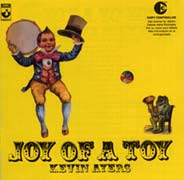
Kevin
Ayers
Joy
Of A Toy
(Emi)
Does
anybody remember Kevin Ayers – or has ever heard of him? I really believe
that – with the exception of those who are heavily into the (so-called) "Canterbury
School" – not too many will, if any. Not a radical innovator, more like
a really good craftsman; a musician who was maybe not fuelled by ambitions
that were burning and deep enough for him to be really successful – and one
who often appeared to be pretty ambivalent about them, too. But Kevin Ayers
is without a doubt a part of the music of that period. Which could be considered
as a judgment of a purely historical value – and so just a pastime for those
who don’t have much curiosity for what’s currently on offer on the market
– save for the fact that in those days, after listening to King Crimson, Henry Cow, Gong, Charles Mingus, Frank Zappa,
Anthony Braxton, Hatfield And The North and Faust there was always somebody
who proposed to listen to a Kevin Ayers album. Which obviously meant that
his records did not suffer too much in this heavy company.
A singer/songwriter and guitar player of simple means which produced
deep results, a former member of Soft Machine (listen to the group’s album
of the same name from 1968, their first), Kevin Ayers is mostly remembered
thanks to his first four albums: Joy Of A Toy (1969), his fresh and extremely
communicative debut; the more complex – and darker – Shooting At The Moon
(1970), in the company of musical misfits Lol Coxill on saxophone and David
Bedford on piano; Whatevershebringswesing (1972), which many regard as his
most mature work; and the easier-on-the-ears and on the surface light-hearted
(but more than a little bit depressed) Bananamour (1973). Not universally
recommended are the stylistic schizophrenic album (starting with the title)
The Confessions Of Dr Dream And Other Stories (’74), which came out roughly
at the same time of the star parade (Brian Eno, John Cale, Nico) later released
as June 1, 1974; and the album titled Rainbow Takeway (from 1978), which saw
the contribution of former Slapp Happy Anthony Moore; but both really deserve
a listen.
Joy Of A Toy is the serene, highly communicative first record which
can be the perfect introduction to Kevin Ayers’s universe. The contrast is
immediately apparent – between the joyous (but listen to the shades in the
arrangement) Joy Of A Toy Continued and the melancholy of Town Feeling, the
communicative verve of The Claretta Rag and the contemplative Girl On A Swing.
While Song For Insane Times – which originally closed side one – is enriched
by the unmistakable performances of Soft Machine as a whole and immediately
makes the list of the best songs penned by Ayers.
It’s quite easy to see behind this record the lysergic London of
the late 1960s: the "power to the imagination" phase, the musical
experimentation, the happenings at the UFO club: Jimi Hendrix, The Incredible String
Band, Syd Barrett’s Pink Floyd, Traffic, The Third Ear Band, AMM. But it won’t
be right to forget about highly influential albums by Donovan such as Sunshine
Superman (1966), Mellow Yellow (1967) and Hurdy Gurdy Man (1968), both for
the sheer internal variety of the records and for the bizarre arrangements
by John Cameron – a lesson that pianist and arranger David Bedford had in
mind when working on Joy Of A Toy. So, there are the usual instruments, plus
melodica, trombone, flute, piccolo, oboe and kazoo – besides those psychedelic
backwards tapes and the incredibly beautiful – and highly distinctive – organ
parts played by Mike Ratledge.
Nice
pictures, fine liner notes which are quite useful to learn more about this
chapter of the story. I can only lament the absence of the full musical credits:
only oboe player Paul Minns (listen to the arrangement of the Ayers classic
The Lady Rachel side by side with the things played by The Third Ear Band
on the shorter tracks of the soundtrack to the movie Machbeth from 1972) is
added to the list of credits from the original LP but it’s vox populi that
both Jeff Clyne (on double bass) and Paul Buckmaster (on cello) played on
the album. Only two song lyrics are reproduced (but there’s always the Web).
The digital mastering is very good – it’s not harsh and it enhances the instrumental
and vocal performances.
The
bonus tracks are not too bad, either: Soon Soon Soon and a heavier orchestral
version of The Lady Rachel come to us from the Odd Ditties anthology (1976);
while Singing A Song In The Morning is a happy 1970 single. The unreleased
tracks are not too harmful – and one of them presents Syd Barret playing guitar.
Beppe
Colli
©
Beppe Colli 2003
CloudsandClocks.net
| Nov. 10, 2003


